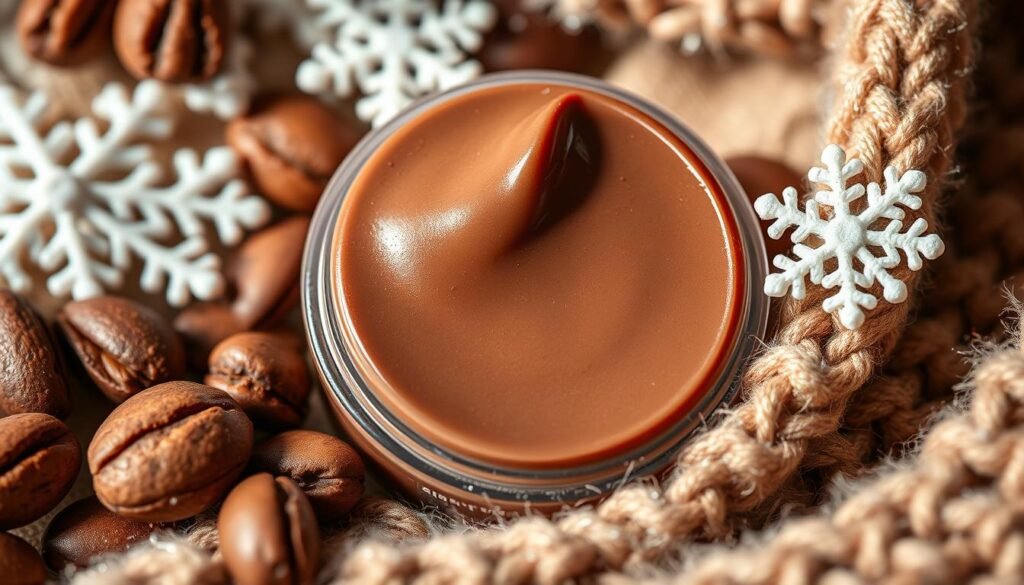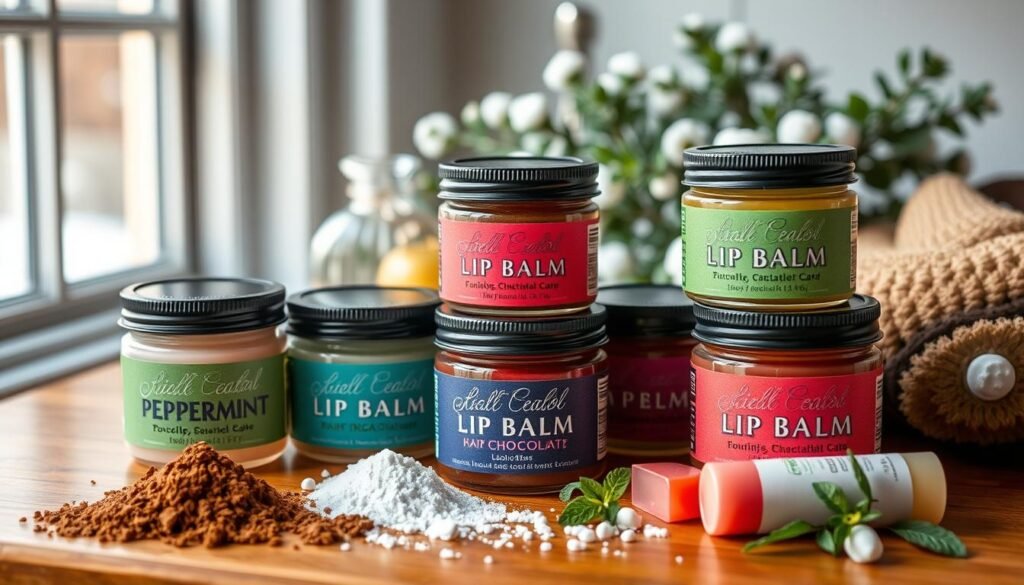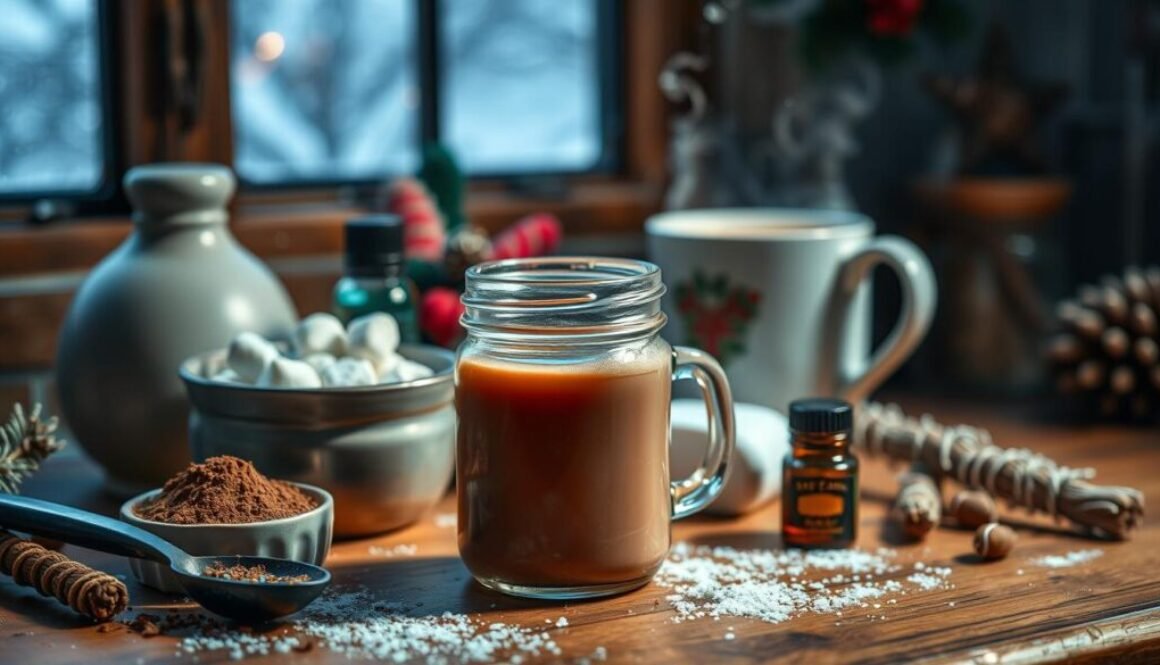DIY Hot Cocoa Lip Balm: Perfect for Winter Care
Making your own lip balms is a fun and easy way to keep your lips healthy. DIY lip balms can help with chapped lips, add color, or protect against cold weather. The best DIY lip balm for winter keeps your lips soft and moist all season.
Key Takeaways
- Homemade lip balm is a simple and effective way to care for your lips during the winter season.
- DIY lip balm recipes can be customized to target specific needs, such as hydration, protection, or color.
- Natural ingredients like cocoa butter and essential oils provide nourishing and soothing benefits for chapped lips.
- Homemade lip balm is more affordable and allows you to control the quality of ingredients compared to store-bought options.
- DIY hot cocoa lip balm offers winter-specific protection and a delightful chocolate flavor.
Why Choose Homemade Chocolate Lip Balm for Winter Protection
When it gets cold, your lips can dry out and crack. But, a homemade DIY beauty products like chocolate lip balm can help. It keeps your lips soft and moist all winter.
Benefits of Natural Ingredients
Homemade lip moisturizer with natural ingredients like cocoa butter is better than store-bought. It deeply hydrates and soothes your lips. Cocoa butter also protects your lips from the sun.
Advantages Over Store-Bought Options
- Customizable to your specific needs and preferences
- Free from potentially irritating synthetic additives
- Cost-effective compared to high-end commercial lip balms
- Allows you to control the quality and source of ingredients
Winter-Specific Protection Features
A homemade chocolate lip balm acts as a shield against winter’s harshness. It locks in moisture and protects your lips from cold winds. This keeps your lips smooth and healthy all winter.
“Homemade lip balm is a game-changer for winter lip care. The natural ingredients deeply nourish and protect, while allowing you to customize the formula to your exact needs.”
Essential Ingredients for Your Hot Cocoa Lip Balm
Making a luxurious cocoa butter lip balm is simpler than you think. The secret to a perfect lip balm for winter is choosing the right natural ingredients. Let’s explore the key components that turn a basic balm into a nourishing treat for your lips.
Cocoa Butter: This ingredient is the main attraction. Cocoa butter deeply hydrates, healing and protecting dry, chapped lips. Its creamy texture blends well with the skin, keeping moisture in.
Shea Butter: Known for its moisturizing and soothing effects, shea butter pairs well with cocoa butter. Together, they make a lip balm that’s soft and creamy.
- Beeswax: This natural wax acts as a shield against winter’s harshness. It seals in moisture and stops it from escaping.
- Jojoba Oil: Its molecular structure is close to the skin’s natural oils. Jojoba oil keeps your lips hydrated and nourished for a long time.
- Vitamin E Oil: As a strong antioxidant, vitamin E oil extends your natural lip care‘s life. It also heals the sensitive lip area.
Choosing these natural ingredients carefully lets you make a homemade cocoa butter lip balm. It soothes, protects, and nourishes your lips with every use.
Required Tools and Equipment for Making Lip Balm
To make your own DIY hot cocoa lip balm, you need a few basic tools. These items help you get the right consistency and texture for your homemade lip care.
Basic Kitchen Tools Needed
- Double boiler or heat-safe bowl for melting ingredients
- Measuring spoons to precisely portion out your DIY lip balm tools
- Stirring utensil like a wooden spoon or silicone spatula
Storage Containers and Options
After making your lip balm, you’ll need a good container to store it. Here are some popular choices:
- Lip balm tubes (typically 5 grams each)
- Small tins or jars (5-10 grams capacity)
- Reusable silicone molds or containers
- Glass jars for a more premium look and feel
Safety Equipment
When working with hot ingredients, safety is key. Here are a few precautions to take:
- Heat-resistant gloves to protect your hands
- Protective eyewear to shield your eyes from splashes
With the right DIY lip balm tools and lip balm containers, you can make your own nourishing hot cocoa lip balm at home.
Step-by-Step diy Hot Cocoa Lip Balm Tutorial
Get ready to treat your lips to a homemade hot cocoa lip balm perfect for winter. This DIY beauty product is super moisturizing and smells like chocolate. It makes you feel warm and cozy. Follow these easy steps to make your own lip balm at home.
- First, collect your ingredients: beeswax, cocoa butter, shea butter, jojoba oil, and vitamin E oil. You can also add your favorite essential oils for extra scent and benefits.
- Next, melt the beeswax, cocoa butter, and shea butter together in a double boiler. Stir occasionally until they’re fully mixed.
- After the butter and wax melt, take the mixture off the heat. Stir in the jojoba oil until it’s well mixed.
- Then, add a few drops of vitamin E oil to nourish and protect your lips.
- If you want, add a few drops of your favorite essential oils, like peppermint or vanilla, to make it smell better.
- Now, pour the hot cocoa lip balm mixture into your lip balm containers, like small tins or tubes.
- Let the lip balm cool completely before using. It takes about 30 minutes to an hour.
This homemade lip balm tutorial makes 3-4 small lip balm containers, each about 5 grams. Enjoy your nourishing and tasty DIY beauty product all winter!
“Homemade lip balms are a game-changer for winter lip care. This hot cocoa recipe is not only indulgent, but it also provides incredible moisture and protection for your delicate lips.”
Cocoa Butter Benefits for Lip Care
Cocoa butter is a top choice for keeping lips moisturized during winter. It creates a barrier to keep moisture in and protect your lip skin.
Moisturizing Properties
Cocoa butter is packed with fatty acids and natural emollients. These help hydrate and soften your lips. Its creamy texture melts into the skin, providing long-lasting lip nourishment.
Natural Sun Protection
While not as strong as SPF, cocoa butter offers some sun protection. Its antioxidants help fight off winter winds and sunlight damage. It’s perfect for your cocoa butter lip balm.
Healing Properties
Cocoa butter’s vitamins A and E soothe and heal chapped lips. It repairs and restores your lip skin, giving you a healthier look.
“Cocoa butter is a true powerhouse ingredient for winter lip care, offering unparalleled moisturization, natural sun protection, and healing properties to keep your lips soft, supple, and nourished all season long.”
Tips for Perfect Consistency and Texture
Getting the right lip balm consistency and homemade lip balm texture is key for a smooth application. Knowing how to mix oils and waxes helps make a balm that feels good and lasts long.
First, think about the oil to wax ratio in your recipe. More beeswax makes the balm firmer, while more oils make it softer. Try different amounts in small batches to find what works best for you.
- Begin with 1 part beeswax to 2-3 parts oils like coconut, shea butter, or jojoba.
- Adjust the mix by adding more beeswax for firmness or oils for softness.
- Mix everything well to avoid clumps or separation.
- Let the balm cool fully before use to get the right firmness.
By following these steps, you can make a lip balm that’s just right. It will be perfect for your lips, keeping them soft and protected, even in the cold winter.
“The secret to a great lip balm is finding the perfect oil to wax mix. A bit of trial and error will help you create a balm that feels amazing on your lips.”

Natural Preservatives and Shelf Life
Making your own DIY lip balm means you get to use natural ingredients. These ingredients are gentle and protect your lips without harsh chemicals. This is a big plus compared to store-bought lip balms.
Adding natural lip balm preservatives like vitamin E oil is key. It can make your lip balm last 6 to 12 months. Vitamin E oil keeps bacteria away and protects the ingredients from damage.
Storage Requirements
Keeping your lip balm in a cool, dry place is important. Avoid direct sunlight. If you live in a warm area, keeping it in the fridge can help it last longer.
Signs of Spoilage
Watch for changes in color, texture, or smell. These could mean your lip balm has gone bad. It’s best to throw it away if you notice any changes.
Using natural preservatives and storing your lip balm right keeps it effective. Your homemade lip balm will protect your lips all winter and beyond.
Customization Options and Variations
Making your own flavored lip balm lets you tailor it to your liking. You can go beyond the usual hot cocoa flavor. Try adding natural ingredients to make unique and nourishing tinted lip balm.
Start with natural flavors like peppermint or vanilla essential oils. They add a refreshing or comforting feel to your lip balm. For color, mix in beetroot powder for a rosy look or cocoa powder for a warm brown shade.
Changing the carrier oils can also enhance your lip balm. Almond oil or coconut oil, for example, moisturize and nourish in their own ways. Adding a bit of food-grade stevia or honey can sweeten it, but be careful not to make it too sticky.
| Customization Ingredient | Benefits |
|---|---|
| Peppermint Essential Oil | Provides a refreshing, tingling sensation and can help plump the appearance of lips. |
| Vanilla Essential Oil | Offers a comforting, aromatic experience and can have a soothing effect. |
| Beetroot Powder | Imparts a natural, rosy tint to the lip balm. |
| Cocoa Powder | Provides a warm, chocolatey hue to the lip balm. |
| Almond Oil | Deeply moisturizes and nourishes the lips. |
| Coconut Oil | Offers antibacterial and skin-soothing properties. |
| Food-Grade Stevia | Adds a touch of natural sweetness without stickiness. |
| Raw Honey | Provides antioxidants and humectant properties for healthier lips. |
There’s no limit to what you can do with your homemade lip balm. Get creative and mix different ingredients to create the perfect lip balm. It should nourish and delight your lips all year round.

Troubleshooting Common Issues
Making your own DIY lip balm can be fun and rewarding. But, you might run into a few small problems. Let’s look at some common issues and find ways to fix them. This way, your homemade lip balm will always be perfect.
Texture Problems
Does your lip balm feel grainy or separated? Don’t worry, it’s a common problem with an easy fix. The main thing is to mix all the ingredients well. Just melt the balm again and mix it well.
This should get rid of any graininess or separation. Your lip balm will be smooth and ready to use.
Melting Point Adjustments
Is your lip balm melting too fast, even in mild temperatures? You can fix this by adding more beeswax. Beeswax helps make the balm harder and keeps it from melting too easily.
If your balm is too hard and hard to apply, add a bit more carrier oil. Jojoba or sweet almond oil works well for this. Remember, changing the recipe a little at a time helps you find the perfect mix.
By trying different amounts of ingredients, you can make your lip balm just right. It will work well in your local climate and feel great on your lips all year.
FAQ
What are the benefits of homemade chocolate lip balm for winter?
Homemade chocolate lip balm deeply hydrates and protects in winter. Ingredients like cocoa butter nourish and heal dry lips. DIY balms avoid harmful chemicals and can be customized.
They create a barrier against cold and wind. This ensures long-lasting relief for winter weather.
What are the key ingredients for making hot cocoa lip balm?
Key ingredients include cocoa butter, shea butter, beeswax, jojoba oil, and vitamin E oil. Cocoa butter nourishes and heals dry lips. Beeswax protects against cold and wind.
Jojoba oil hydrates like skin’s natural oils. Vitamin E oil acts as an antioxidant, extending shelf life.
What tools and equipment are needed to make lip balm at home?
You’ll need a double boiler or heat-safe bowl, measuring spoons, and a stirring utensil. Storage options include lip balm tubes, small tins, glass jars, and silicone containers. Safety gear like gloves and protective eyewear is also important.
How do you make hot cocoa lip balm step-by-step?
Melt beeswax, cocoa butter, and shea butter in a double boiler. Add jojoba oil and mix well. Remove from heat, then add vitamin E oil and optional essential oils.
Pour into lip balm containers. Let it cool and solidify completely. This makes 3-4 small lip balm containers (5 grams each).
What are the benefits of using cocoa butter in lip balm?
Cocoa butter deeply moisturizes and protects. It offers natural sun protection, though not as effective as SPF. It heals dry, cracked lips and provides long-lasting nourishment, perfect for winter.
How can you customize your homemade lip balm?
Add natural flavors like peppermint or vanilla essential oils. Use beetroot powder for a rosy tint or cocoa powder for a warm brown shade. Try different oils like almond or coconut for varied benefits.
Add a small amount of food-grade stevia or honey for sweetness. But use it sparingly to avoid stickiness.
How do you troubleshoot common texture issues with homemade lip balm?
Graininess or separation can be fixed by remelting and mixing well. For balms that melt too easily, add more beeswax. If it’s too hard, add more oils.
Adjust ingredient ratios in small increments. This helps achieve the right consistency and melting point for your climate.
